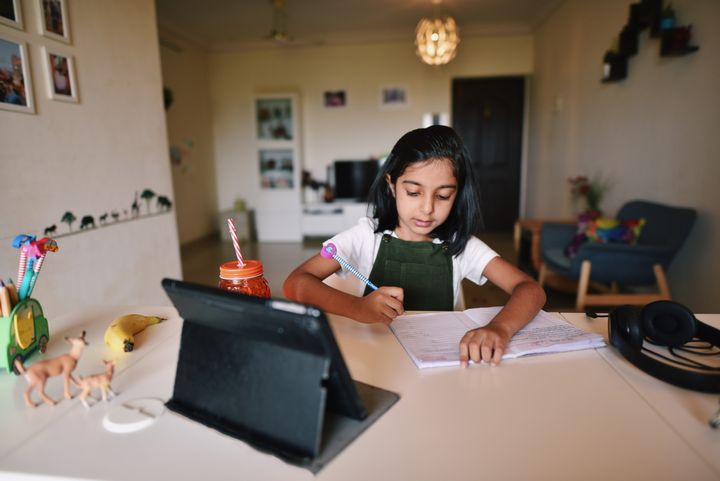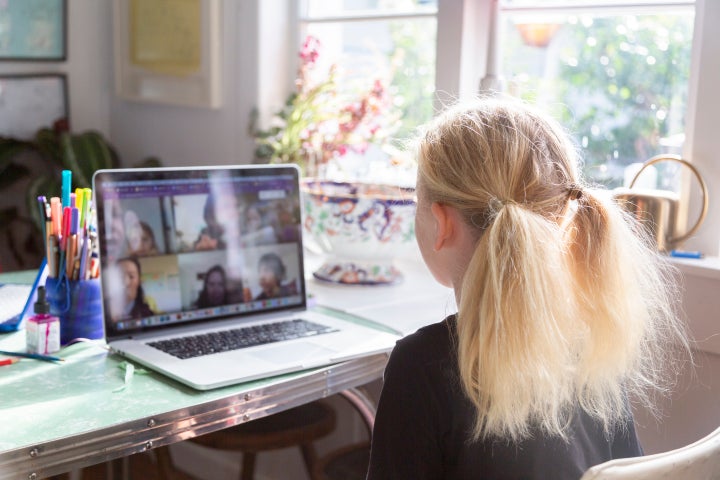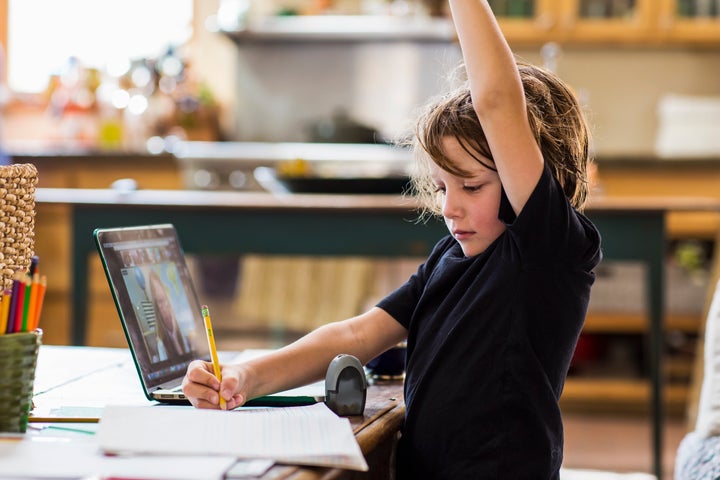
Remote learning often comes with technical difficulties, but it also can bring about challenges with student engagement.
By now, most students have been in school for about a month and a half to two months, so if you’re a parent, you’ve likely noticed some patterns with your child’s at-home education. Some parents might be surprised to find that their normally talkative child who had no issues participating in class in the past is quite reserved in the virtual classroom.
“A child can be shy in the Zoom situation and outgoing in a real-life situation,” psychologist Sanam Hafeez told HuffPost. “For most people, feeling at ease on camera is a learned behavior, not something that is innate. Just as adults can be completely comfortable in person, if you put them on Zoom, they too can feel shy and self-conscious.”
To help understand this phenomenon, HuffPost spoke to experts about the reasons a child might be shy on screen but not in real life. Read on to learn why this is a perfectly normal and expected response.
They’re hyper-aware of how they appear.
“Children might become shy or apprehensive for video calls related to school because they are able to readily see themselves,” said licensed clinical psychologist Cindy Graham.
In most interactions with others, we aren’t staring at our own faces right in front of us while talking. But video conferencing systems often force us to do this.
“This is an entirely new situation for everyone ― teachers, students and parents ― and new situations can cause anyone to be apprehensive, nervous or shy,” said Sarah Brown Wessling, the 2010 National Teacher of the Year who has been working with the video communications company Prezi to help teachers and students adjust to distance learning.
“This feeling can be amplified when students see and hear themselves during a live video class,” added Wessling, a Johnston, Iowa, English teacher. “Just think how we cringe when we hear our own voicemail and wonder, ‘Is that really me?’ Students can feel similarly when transitioning to a live video-based class.”
Feeling a sense of “virtual stage fright” on video calls is natural, even for students who aren’t typically shy in the classroom. Graham noted that this environment lends itself to self-criticism as students see their facial expressions and upper body movements in real time.

“By seeing themselves on video, kids are able to see their ‘quirks’ and therefore may create overly negative assumptions about their appearance and mannerisms,” she explained. “Whether a child is shy or not, observing their behaviors and features for hours throughout the day may lead them to hyper-focus on aspects that others may not notice at all.”
They feel like all eyes are on them.
In a typical school classroom, students tend to sit in rows of desks facing the teacher, with a view of each others’ backs and sides. Sometimes they’re arranged in a circle, but even then, they aren’t as visible as they are in a remote learning setting.
The virtual classroom setup adds a layer of intimidation as all of their faces may be visible at all times, and when a student speaks, their face typically occupies a larger section of the screen.
“The camera lens mimics that of a microscope, projecting a student’s face into predominance on a screen for their whole class to see,” said Meredith Essalat, a school principal and author of “The Overly Honest Teacher.” “It can certainly feel far more intrusive than when students are all together in the classroom.”
Thus, in addition to self-scrutiny, students may feel the eyes of their peers upon them, which breeds discomfort.
“This can be true for children who aren’t shy in person because the experience and perceived expectations of the virtual classroom are different,” said Isaiah Pickens, a clinical psychologist and the CEO of iOpening Enterprises. “Some of those expectations include being ready for the camera to be solely focused on the student when they speak, as opposed to the in-person classroom, when students speak there is a host of other distracting experiences that feel like they diffuse the full focus of others away from a single student.”
“Our nonverbal communication, such as supportive nods and smiles of encouragement from other kids and the teacher, can be lost or hard to see in videoconferencing.”
- Jessica Foster, developmental and behavioral pediatrician at Akron Children’s Hospital
They’re self-conscious about their background.
Beyond their concerns about how they present themselves on screen, students may also be insecure about what others can see in the background.
“The child may be worried that the class can see their home environment or bedroom, or that a sibling or parent will embarrass them in the background,” said Elizabeth Milovidov, a law professor and digital parenting expert with Tone Networks.
Even children whose home situations are relatively “normal” may just feel general insecurity about giving others a glimpse into their private lives.
“Students may become hypersensitive to experiences in the home that can embarrass them, including a background that is unclean or chaotic with several family members due to limited space,” Pickens said.
For many children, school offers a welcome escape from a difficult home environment. The remote learning experience unfortunately fuses the two experiences, which can lead to extra concerns about what their peers are thinking based on what they see of their private life.
“This can be especially true for tweens and teens who are sensitive to their social status and may feel embarrassed about showing details about their living arrangements to other students and staff,” Dr. Jessica Foster, a developmental and behavioral pediatrician at Akron Children’s Hospital in Ohio, told HuffPost.
They don’t feel as connected to others.
Virtual classrooms make it a bit harder to feel a connection to the teacher and other students.
“Our nonverbal communication, such as supportive nods and smiles of encouragement from other kids and the teacher, can be lost or hard to see in videoconferencing,” Foster said. “Encouraging comments from peers that might occur in an in-person classroom setting can also be missing in a video format.”
Without the visual cues, like body language and eye contact, students may need more time to feel understood and safe in their new classroom setting and to forge a sense of community and rapport with their peers.
“Anyone can feel shy when presenting on video, even children who aren’t normally shy and usually feel comfortable speaking in class,” Wessling said. “Often teachers will help students gain confidence by affirming their strong ideas or even letting them know a few minutes ahead of time that the student should share with the whole class when it’s time for volunteers.”
For some students, the disconnectedness of remote learning can be difficult in itself.
“Students are craving community,” Essalat said. “They miss their friends and classmates, the routine of being on campus and going outside to play at recess or engage in the tactile learning that comes from art class. Seeing everyone on screen is a fine option, but, to many kids, it just doesn’t fill the void of familiarity they are seeking.”

There are technological challenges.
“Navigating online learning requires practice,” Essalat said. “Learning where the ‘mute’ and ‘video’ buttons are, how to go and come back from a breakout room, knowing that even though they are seated by themselves at home, their every move is projected into the digital divide ― these are all added layers of their day-to-day to which they have to grow accustomed. And, so often, when something feels unfamiliar or out of their control, our students simply shut down.”
Getting comfortable with the online systems can be a challenge. If the student has issues with internet access or struggles with the videoconference platform, this can add stress and anxiety that didn’t exist in the traditional classroom setting.
“Perhaps they just do not feel as competent with a piece of technology in front of them,” Milovidov noted. “Technology adds another dimension to the classroom. A child may be worried that they need to mute/unmute quickly or that they need to demonstrate their tech competence.”
They have new norms to learn.
Wessling noted that the procedures in virtual classrooms can be unclear, as kids are learning new ways to take turns or “raise their hand” in this environment.
“It’s also important to remember that even in face-to-face classrooms it can take quite a while for some students to feel comfortable sharing with the whole class,” she explained. “This requires a lot of trust in the teacher and in the other students. That’s why teachers often create small groups in face-to-face classrooms, especially early in the school year. Some video platforms have the capability to create small groups while others don’t.”
The online environment can get a bit overwhelming if not properly managed (think dozens of unmuted preschoolers on Zoom). Additionally, watchful parents may not be aware of the process kids engage in.
“Until school went online, parents didn’t get to observe their children on the first day after we dropped them off,” said Meghan Fitzgerald, an educator who founded the outdoor early-learning program Tinkergarten. “What we’ve never seen, and what teachers see every year, is how long it can take kids to come out of their shells in a new classroom ― that is no less true in an online setting. Most kids take their time, learn the norms, then start to put themselves out there. When you think about it, that is a pretty wise approach to new situations. The choice to look on and hang back may be even more likely in an online classroom for several reasons.”
“We are almost literally being asked to be very different people with a new set of skills for the online experience.”
- psychotherapist Noel McDermott
They just need some time and help.
Another reason for a typically outgoing child to be more reserved in a virtual classroom? Normal growing pains.
“Some children are adjusting to a new classroom environment, some are realizing they have new eyeballs watching them (their caregivers at home!), some children have a learned behavior and some children are just out of their comfort zones on Zoom ― all totally normal things!” said Megan Allen, 2010 Florida Teacher of the Year and founder of Tailored Learning Supports for Families.
The remote learning experience can feel very strange and make it harder to be authentic and comfortable in your skin.
“Being shy with the online platforms is perfectly normal. It’s our current situation that is new and requires a period of adaptation on our part,” said psychotherapist Noel McDermott. “Online requires a new set of skills, and being shy in this media and not in real-world situations is perfectly normal. We are almost literally being asked to be very different people with a new set of skills for the online experience. It’s important with kids, and all of us, to normalize this.”
Adapting to the “new normal” brings up uncomfortable feelings and conflicts that don’t necessarily have easy solutions, but parents should avoid the temptation to ignore them.
Clinical psychologist Nuanprang Snitbhan offered guidance to caregivers helping children navigate remote learning.
“My first advice to parents is this: Remind yourself every morning that we are all learning together, and it’s OK to not be perfect.”